 Gilman Studio On-Line Lessons
Gilman Studio On-Line Lessons
Yang Style
Tai Chi Dao/Saber/Broadsword
This Lesson Contains:
Movement # 1 – Commencement of Tai Chi Saber & Movement # 2 – Step Up to Form Seven Stars
Here we go. It is always exciting to get started on learning a new form. I will do my best to make it clear to you.
These first two movements appear as one. This is one of the mysteries of learning forms – sometimes things are not what I would think they would be. Commencement, as I learned it, is kind of a transition into Seven Stars. Together with the following movement, Retreat to Ride a Tiger, they make up a rather long introduction or getting ready. I have made up applications for these movements, but will not include them here. We will just use this opening series as a getting ready and facing the opponent.
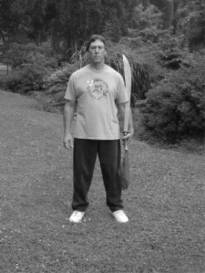
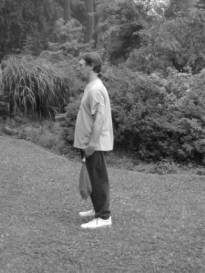 #1 – Commencement of Tai Chi Saber
#1 – Commencement of Tai Chi Saber
Stand in Wu Chi stance. Feet solidly on the ground with the feet shoulder width apart. Grip the saber in your left hand. Make sure the sharp edge is facing outward. Keep your head up, lifting it with Peng (expanding, balloon like energy) from the Dantien (main physical energy center located in the lower abdomen). Stay relaxed, and expand your field of awareness all around the body. Breathe naturally in and out through the nose.
Note: We will call this starting direction north, even if it isn’t. All directions will relate to this starting direction.
The first picture will be taken from north or straight ahead. The second will be taken from the west or left hand side of the starting position.
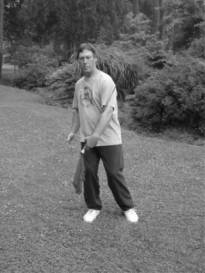
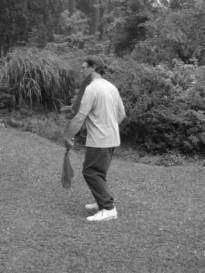 #2 – Step Up to Form Seven Stars
#2 – Step Up to Form Seven Stars
Shift the weight on to the right foot, and sink the weight into the right Kua (hip area). This causes a spring like quality to form in the right leg. The left leg empties and you roll up onto the left toe.
The torso turns slightly to the right. Bring the arms to the right with the turn. This is actually the start of a swinging motion that will result in the saber being lifted up to the center of the chest as the body turns to the left.
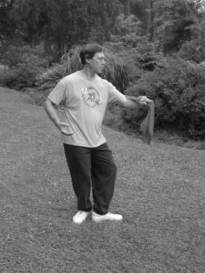
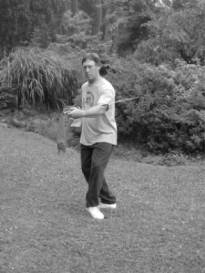 Starting to open to the left. Bringing the saber up to center for defense or a possible strike with the pommel (end of the handle).
Starting to open to the left. Bringing the saber up to center for defense or a possible strike with the pommel (end of the handle).
Lift up the left foot and replace it in front of and slightly to the left of the right foot. The toe faces half way between west and south. The weight is still on the right foot.
The torso is turning to the left in order to make this replace step possible.
The right hand is lifted to the waist level and turns palm upward. It is starting to form a fist.
The left hand holding the saber swings up in a counterclockwise circle to end in front of the center of the chest. The left palm faces upward. The left elbow is bent. This movement has a Peng or spiral quality (expanding up and out).

 Coming into Seven Stars position.
Coming into Seven Stars position.
Shift the weight onto the left foot and replace the right foot onto Ding Bow on toe. The right empty stance allows for mobility, and the ability to use the right foot for kicking or blocking. The body now faces west.
It is the torso turning and opening to the left that allows the right leg to be brought into position.
The left arm remains in the center of the chest. Notice that the saber is parallel to the ground.
The right hand has formed a fist and is placed under the left wrist with the palm surface facing down. Notice that the two wrists are almost touching. Keep the shoulders and elbows relaxed.
Focus on the two fists.
Note: The first part of this movement can be used to strike a close in target with the pommel and the second part can be a block of a foot kick or a strike to the center.
